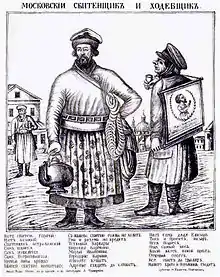Sbiten
Sbiten or sbiten' (Russian: сбитень) hot winter Belarusian,[1] Ukrainian,[2] and Russian traditional drink. It has a dark purple appearance and, depending on the recipe, can be very spicy and/or very sweet.
_%D1%80%D0%B6%D0%B0%D0%BD%D0%BE%D0%B9.JPG.webp)

History
First mentioned in Slavonic chronicles in 1128, it remained popular with all classes of East Slavic society until the 19th century when it was replaced by coffee and tea.[3] It is being revived in the 21st century as a mass-produced drink in Russia.
Preparation
Like mead and medovukha, sbiten' is based on honey mixed with water, spices, and jam. One recipe of sbiten' is described in the 16th-century Domostroy. Compared to kvass, sbiten' is very simple to prepare. In some recipes, honey and sbiten' flavor (spices, juices) are boiled down and then these two parts are combined and boiled again. In other recipes, all the ingredients are combined and boiled at once. The drink can also be made alcoholic by substituting red wine for the water. It can be garnished with mint leaves or cinnamon sticks.
It can also be served cold during the summer.

Sbitenshchik
Sbitenshchik (Russian: сбитенщик) was a sbiten vendor in Kievan Rus', Muscovite Rus' and Russian Empire. The tradition began in the 12th century.
The comic opera The Sbiten Vendor (Сбитенщик – Sbitenshchik) by Yakov Knyazhnin with music by Czech composer Antoine Bullant, 1783, was very popular in 18–19th centuries in Russia. Sbitenshick played an important role in the development of the samovar.
See also
References
- Ėtnahrafii︠a︡ Belarusi : ėntsyklapedyi︠a︡. Shami︠a︡kin, Ivan. Minsk: "Belaruskai︠a︡ sav. ėntsyklapedyi︠a︡ imi︠a︡ Petrusi︠a︡ Broŭki". 1989. ISBN 5-85700-014-9. OCLC 22068282.CS1 maint: others (link)
- "Інститут мовознавства ім. О.О.Потебні | Словник української мови". www.inmo.org.ua. Retrieved 18 December 2020.
- "Sbiten' Honey-based concentrates". Retrieved 27 December 2014.
External links
- How to Make Sbiten - wikiHow article